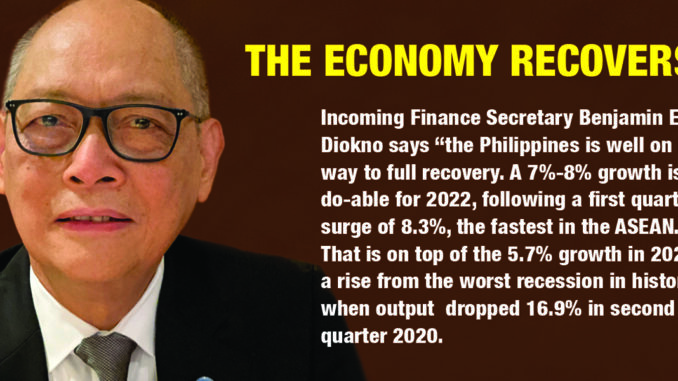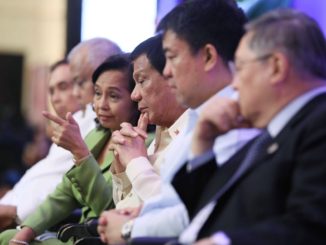
By Benjamin E. Diokno, Ph.D.
BSP Governor
(The incoming Finance secretary gave a bullish outlook for the economy in his zoom speech before the Rotary Club of Manila, June 9, 2022)
Good day, fellow Rotarians. Thank you for inviting me.
Today, I’ll go over the country’s strong economic performance and how we plan to sustain this momentum through and beyond the pandemic.
Let me start by saying: the Philippines is well on its way to full recovery.
After the pandemic-driven recession in 2020, the economy grew by 5.7% last year followed by an 8.3% growth in the first quarter of 2022. The Philippines’ latest GDP growth rate exceeds that of Malaysia, Indonesia, Vietnam, Singapore, and Thailand.
We expect the economy to grow much faster in the second quarter, making the growth target for this year of 7-8% doable.
The employment rate is close to its pre-pandemic level.

From a peak of 17.6% in April 2020, the unemployment rate is down to 5.8% in March this year.
Foreign direct investments reached an all-time high last year, growing by 54.2%. In the first two months of 2022, FDIs rose 8% to $1.7 billion.
Manufacturing activity has strongly rebounded.
The purchasing managers’ index hit 54.1 in May, representing nine months of expansion in factory activity.
Likewise, both business sentiment and consumer outlook have improved.
In less than a month, we will be ushering in a new administration that will tackle some pressing challenges.
But even as the country transitions from one administration to another, the Bangko Sentral ng Pilipinas will continue to fulfill its mandate of ensuring sound macroeconomic management.
The strong rebound in domestic economic activity and labor market conditions provided scope for the BSP to start rolling back its pandemic-induced interventions.
The BSP’s provisional advances to the National Government amounting to P540 billion in 2020 and 2021 was reduced to only P300 billion in January 2022.
In another part of our policy normalization process, we reconfigured the government securities purchasing window from a crisis intervention measure into a regular liquidity facility.
But as we unwind our pandemic-era interventions, let me stress that the economy entered this crisis from a position of strength.
Our healthy external accounts and hefty gross international reserves served as buffer during the pandemic.
As of end-May, our gross international reserves stood at $103.53 billion, representing 9.1 months worth of import cover.
The government’s fiscal space allowed it to finance its huge COVID-19 response without incurring unmanageable public sector debt.
At its current ratio, our debt-to-GDP ratio remains quite manageable. Given the strong rate of economic expansion, the country can easily outgrow its debt.
Moreover, we implemented a series of reforms to our tax system. We reduced income tax, equivalent to one month’s salary.
We cut corporate income tax to make it more competitive with our ASEAN peers. We simplified the tax structure, rationalized fiscal incentives, increased excise taxes on oil, cigarettes, and sweetened beverages.
In brief, the tax system that the Duterte administration will transmit to the BBM administration is much better than the tax system that the former received from the Aquino administration.
During the pandemic, the administration didn’t sit idly and wait for the coronavirus to recede. Instead, it continued to pursue game-changing reforms.
Three landmark laws
Congress approved three landmark laws that further open the Philippines to foreign investors, namely: The amended Retail Trade Liberalization Act, the Foreign Investments Act, and Public Services Act.
Areas open to 100% foreign equity
For me, the Public Service Act, an almost 90-year project, is the best of three since it enables foreign investors to come and invest in railways, toll roads, shipping, among many other sectors of the economy.
Taking all these into consideration, we are optimistic that the Philippine economy will perform even better this year. With the economy growing at 8.3% in the first quarter, we expect it to grow by 7% to 8% this year, and by 6% to 7% next year (2023).
In closing, let me share the incoming administration’s goals. You might have heard that the President-elect met with his economic team this week.
During that meeting, we outlined three broad goals: by the end of the President’s term, we hope to reduce the deficit-to GDP ratio to 3%, achieve upper-middle-income country status, and reduce poverty incidence to single digits.
I trust that everyone can lend their support as we work towards these goals for the nation and its people.
Thank you for your attention.

